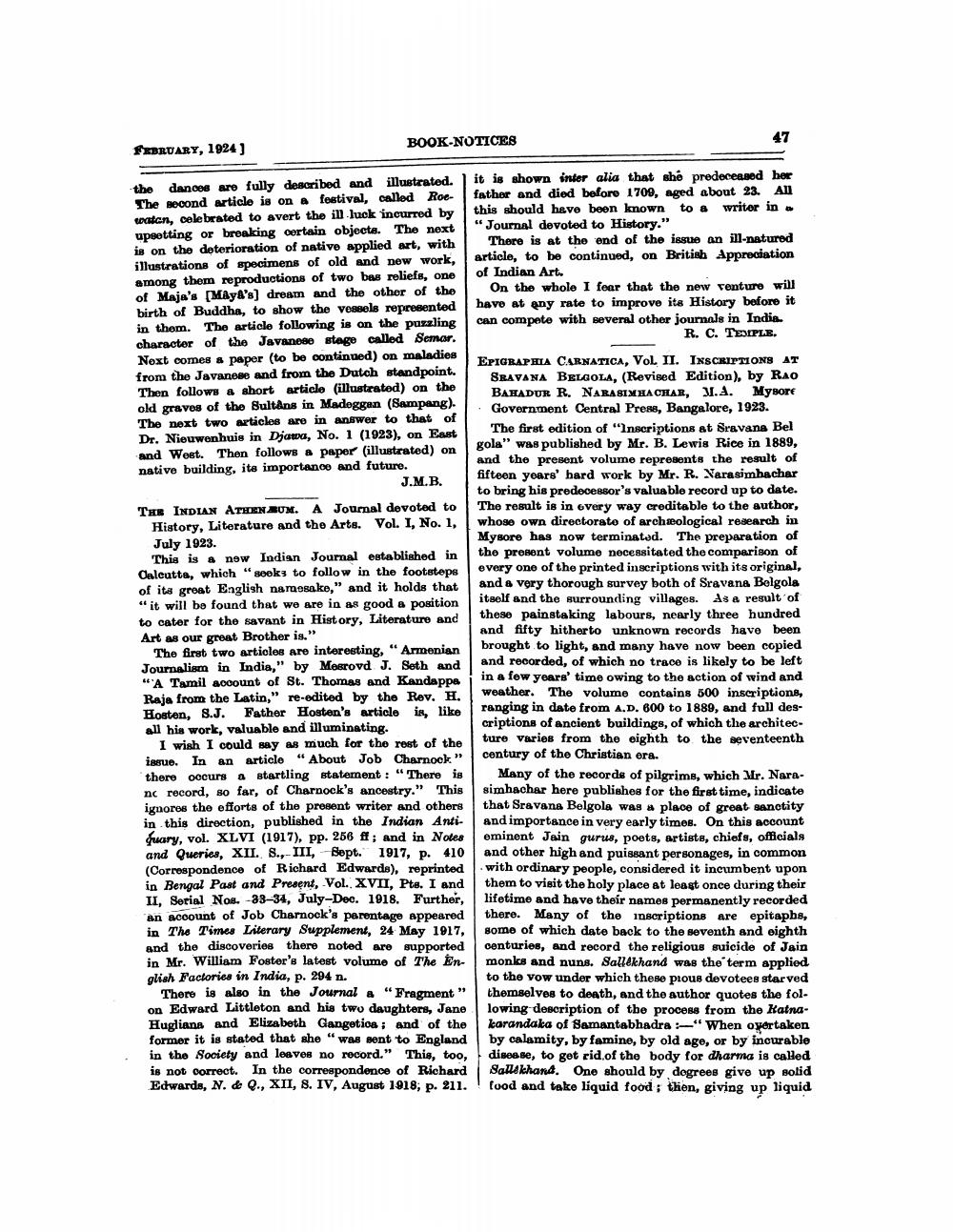________________
BOOK-NOTICES
47
FEBRUARY, 1924 ]
the dances are fully described and illustrated. it is shown inter alia that she predeceased her The second article is on a festival, called Roe- father and died before 1709, aged about 23. All
vart the in luck incurred by this should have been known to & writor in waten, celebrated to avert the illuck incurred by upeotting or breaking certain objects. The next "Journal devoted to History."
There is at the end of the issue an ill-natured is on the deterioration of native applied art, with illustrations of specimens of old and new work, article, to be continued, on British Appreciation
of Indian Art. among them reproductions of two bas reliefs, one
On the whole I fear that the new venture will of Maja's (Maya's) dream and the other of the birth of Buddha, to show the vessels represented have at any rate to improve its History before it in them. The article following is on the puzzling can compete with several other journals in India character of the Javanese stage called Semar.
R. C. TEDIPLE. Next comes & paper to be continued) on maladies
EPIGRAPHIA CARNATICA, VOL II. INSCRIPTIONS AT from the Javanese and from the Dutch standpoint.
SRAVANA BELGOLA, (Revised Edition), by Rao Then follows & short article (illustrated) on the
BAHADUR R. NARASIMHACHAR, J.4. Mysore old graves of the Sultans in Madoggan (Sampang).
Government Central Press, Bangalore, 1923. The next two articles are in answer to that of
The first edition of "Inscriptions at Sravana Bel Dr. Nieuwenhuis in Djawa, No. 1 (1923), on East
gola" was published by Mr. B. Lewis Rice in 1889, and West. Then follows a paper (illustrated) on
and the present volume represents the result of native building, its importance and future.
J.M.B.
fifteen years' hard work by Mr. R. Narasimhachar
to bring his predecessor's valuable record up to date. THE INDIAN ATHENRUM. A Journal devoted to The result is in every way creditable to the author,
History, Literature and the Arts. Vol. I, No. 1, whose own directorato of archaeological research in July 1923.
Mysore has now terminated. The preparation of This is a new Indian Journal established in
the present volume necessitated the comparison of Calcutta, which "seeks to follow in the footsteps every one of the printed inscriptions with its original, of its great English namesake," and it holds that and a very thorough survey both of Sravana Belgola " it will be found that we are in as good a position
itself and the surrounding villages. As a result of to cater for the savant in History, Literature and
these painstaking labours, nearly three hundred Art as our great Brother is."
and fifty hitherto unknown records have been The first two articles are interesting, "Armenian brought to light, and many have now been copied Journalism in India," by Mesrovd J. Seth and and recorded, of which no trace is likely to be left "A Tamil account of St. Thomas and Kandappa
in a few years' time owing to the action of wind and Raja from the Latin," re-edited by the Rev. H. weather. The volume contains 500 inscriptions, Hosten, S.J. Father Hosten's article is, like
ranging in date from A.D. 600 to 1889, and full desall his work, valuable and illuminating.
criptions of ancient buildings, of which the architecI wish I could say as much for the rest of the
ture varies from the eighth to the seventeenth issue. In an article "About Job Charnock"
century of the Christian era. there oocurg a startling statement : "There is Many of the records of pilgrims, which Mr. Naranc record, so far, of Charnock's ancestry." This simhachar here publishes for the first time, indicate ignores the efforts of the present writer and others that Sravana Belgola was a place of great sanctity in this direction, published in the Indian Anti- and importance in very early times. On this account quary, vol. XLVI (1917), pp. 256 ff; and in Notes eminent Jain gurus, poets, artists, chiefs, officials and Queries, XII. S. -III, Sept. 1917, p. 410 and other high and puissant personages, in common (Correspondence of Richard Edwards), reprinted with ordinary people, considered it incumbent upon in Bengal Past and Present, Vol. XVII, Pte. I and them to visit the holy place at least once during their II, Serial Nos. 33–34, July-Doc. 1918. Further, lifetime and have their names permanently recorded an account of Job Charnock's parentage appeared there. Many of the inscriptions are epitaphs, in The Times Literary Supplement, 24 May 1917, some of which date back to the seventh and eighth and the discoveries there noted are supported centuries, and record the religious suicide of Jain in Mr. William Foster's latest volume of The En- monks and nuns. Sallékhand was the term applied glish Factories in India, p. 294 n.
to the vow under which these prous devotees starved There is also in the Journal a "Fragment " themselves to death, and the author quotes the fol on Edward Littleton and his two daughters, Jane lowing description of the process from the katna. Huglians and Elizabeth Gangetios; and of the karandaka of Samantabhadra -"When overtaken former it is stated that she was sent to England by calamity, by famine, by old age, or by incurable in the Society and leaves no record." This, too, disease, to get rid of the body for dharma is called is not correct. In the correspondence of Richard Sallakhand. One should by degrees give up solid Edwards, N. & Q., XII, S. IV, August 1918, p. 211.! food and take liquid food; then, giving up liquid




